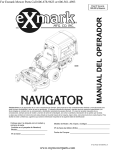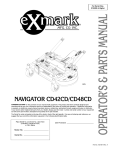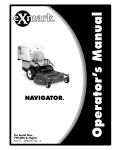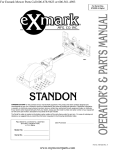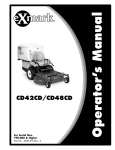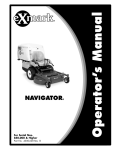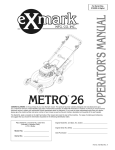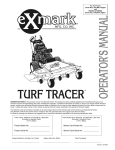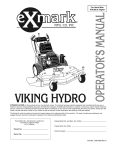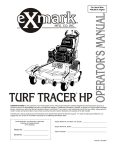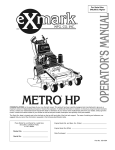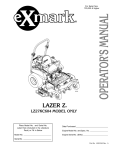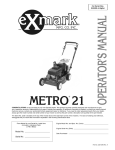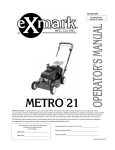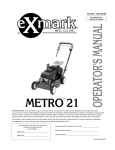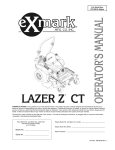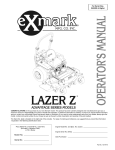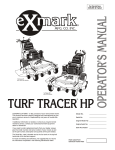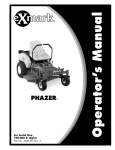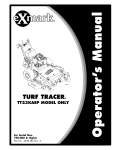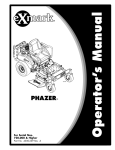Download Exmark NAV20KC User's Manual
Transcript
For Serial Nos. 510,000 & Higher Part No. 103-8573 Rev. B WARNING POTENTIAL HAZARD ♦ This product is a piece of power equipment. WHAT CAN HAPPEN ♦ Failure to follow safe operating practices can result in serious operator injury or even death. HOW TO AVOID THE HAZARD ♦ Keep all shields, guards, and safety devices (especially the grass discharge system) in place and in proper working condition. ♦ Stop engine and wait for all moving parts to stop. Remove spark plug wire(s) or remove key before adjusting, servicing, or performing maintenance. ♦ If mower deck becomes clogged, stop engine and wait for all moving parts to stop. Remove spark plug wire(s) or remove key before cleaning blockage. ♦ Keep hands, feet, and clothing away from power driven parts. ♦ Keep off mower unless seat platform is provided. ♦ Keep others off mower. WARNING POTENTIAL HAZARD ♦ Gasoline is harmful or fatal if swallowed. Long-term exposure to vapors has caused cancer in laboratory animals. WHAT CAN HAPPEN ♦ Failure to use caution may cause serious injury or illness. HOW TO AVOID THE HAZARD ♦ Avoid prolonged breathing of vapors. ♦ Keep face away from nozzle and gas tank/container opening. ♦ Keep away from eyes and skin. ♦ Never siphon by mouth. IMPORTANT When the mower is used or operated on any California forest, brush or grass covered land, a working spark arrester must be attached to the muffler. If not, the operator is violating state law, Section 4442 Public Resource Code. To acquire a spark arrester for your unit, see your Engine Service Dealer. This spark ignition system complies with Canadian ICES-002 Ce système d’allumage par ètincelle de vèhicule est conforme à la norme NMB-002 du Canada The enclosed Engine Owner’s Manual is supplied for information regarding The U.S. Environmental Protection Agency (EPA) and the California Emission Control Regulation of emission systems, maintenance and warranty. Keep this engine Owner’s Manual with your unit. Should this engine Owner’s Manual become damaged or illegible, replace immediately. Replacements may be ordered through the engine manufacturer. -i- EXMARK PARTS PLUS® PROGRAM EFFECTIVE DATE: September 1, 1995 Program If your Exmark dealer does not have the Exmark part in stock, Exmark will get the parts to the dealer the next business day or the part will be FREE* Guaranteed!! How the Program Works 1. If dealer does not have part in stock for a "down" unit at the time of request by customer, the dealer contacts his distributor by 1:00 p.m., local time, and requests Exmark Parts Plus® shipment of six (6) line items or less. 2. Distributor ships part(s) to dealer or customer, as requested by dealer, same day, overnight UPS Distributor bills dealer for part and freight charges where applicable. 3. If distributor does not have the part(s) in stock to satisfy Exmark Parts Plus® order, he contacts Exmark by 3:00 p.m., central time, with an Exmark Parts Plus® order of six (6) line items or less. 4. If order is received by 3:00 p.m. central time, Exmark ships part(s) direct to dealer or customer, as requested by distributor, same day, overnight UPS, Exmark bills the distributor for parts and shipping charges, where applicable. 5. The customer pays for the part and freight if it is shipped under the Exmark Parts Plus® and if it arrives in accordance to the program. 6. Who pays for the part and freight if it fails to arrive overnight in accordance to the program? A. Under any circumstance the customer does not pay. B. If the part does not arrive overnight due to: 1. The dealer not submitting the Exmark Parts Plus® order to his Exmark distributor by 1:00 p.m., the dealer pays for the part and freight. 2. The Distributor being unable to ship the part the same day or not submitting the Exmark Parts Plus® order to Exmark by 3:00 p.m., central time, the Distributor pays for the part and freight. 3. Exmark being unable to ship the part and the Exmark parts order is received by 3:00 p.m., central time, Exmark pays for the part and freight. 4. If the part does not arrive overnight due to the shipper (UPS), the shipper pays for the freight and Exmark pays for the part. The following restrictions apply -- The Exmark Parts Plus® Program is available only through participating Exmark Dealers and applies only to orders submitted on this program Monday through Thursday. Parts Plus service is available only in the 48 contiguous United States. UPS has initiated a Saturday delivery program to many areas of the continental United States and can be requested for an overnight shipment on Friday to be delivered Saturday. The next day air charge, plus the Saturday delivery fee will be the responsibility of the purchaser. Exmark Mfg. will assume no responsibility for Saturday delivery shipments. To qualify, all Exmark Parts Plus® orders must be received by Exmark by 3:00 p.m., central time. Orders must be six (6) line items or less. Exclusions from the Exmark Parts Plus® Program are: Any wholegood or accessory in its entirety, engines and engine replacement parts, 5-speed Peerless transmissions and 5-speed transaxles, hydraulic or hydrostatic wheel motors, cutter decks and engine decks or any item exceeding United Parcel Service size and weight restrictions. Due to UPS restrictions, aerosol spray paint is considered a hazardous material and cannot be shipped via UPS next day or Second Day Air. Exmark Manufacturing stocks a limited supply of parts for transaxles, pumps and wheel motors. These parts can be ordered for Next Day Air shipment but will not be guaranteed per the Parts Plus Program. - ii - CONGRATULATIONS on the purchase of your Exmark mower. This product has been carefully designed and manufactured to give you a maximum amount of dependability and years of trouble-free operation. OPERATOR'S MANUAL This manual contains assembly, operating, maintenance, adjustment, and safety instructions for your Exmark mower. BEFORE OPERATING YOUR MOWER, CAREFULLY READ THIS MANUAL IN ITS ENTIRETY. By following the operating, maintenance, and safety instructions, you will prolong the life of your mower, maintain its maximum efficiency, and promote safe operation. If additional information is needed, or should you require trained mechanic service, contact your authorized Exmark equipment dealer or distributor. All Exmark equipment dealers and distributors are kept informed of the latest methods of servicing and are equipped to provide prompt and efficient service in the field or at their service stations. They carry ample stock of service parts or can secure them promptly for you from the factory. All Exmark parts are thoroughly tested and inspected before leaving the factory, however, attention is required on your part if you are to obtain the fullest measure of satisfaction and performance. -iii- TABLE OF CONTENTS 1. SAFETY 1.1 1.2 1.3 1.4 1.5 1.6 PAGE Safety Alert Symbol ....................................................................................... 1 Training ......................................................................................................... 1 Preparation................................................................................................. 1-3 Operation ................................................................................................... 4-6 Maintenance & Storage .............................................................................. 6-7 Safety Signs ............................................................................................. 8-10 2. SPECIFICATIONS 2.1 2.2 2.3 2.4 2.5 2.6 2.7 2.8 2.9 2.10 2.11 Model Number ............................................................................................. 10 Engine ......................................................................................................... 10 Fuel System ................................................................................................ 10 Electrical System .................................................................................... 10-11 Operator Controls........................................................................................ 11 Seat............................................................................................................. 11 Hydrostatic Ground Drive System ............................................................... 11 Tires ............................................................................................................ 12 Mower Deck ................................................................................................ 12 Dimensions.................................................................................................. 12 Torque Requirements.................................................................................. 12 3. ASSEMBLY INSTRUCTIONS 3.1 3.2 3.3 3.4 3.5 3.6 Uncrate Mower ............................................................................................ 12 Service Battery ....................................................................................... 12-13 Install Drive Wheels..................................................................................... 13 Check Tire Pressure.................................................................................... 13 Service Engine ............................................................................................ 13 Service Hydraulic Oil ................................................................................... 14 4. OPERATION INSTRUCTIONS 4.1 4.2 4.3 4.4 Controls.................................................................................................. 14-16 Pre-Start...................................................................................................... 16 Operating Instructions ............................................................................ 16-18 Transporting ........................................................................................... 18-19 5. MAINTENANCE & ADJUSTMENTS 5.1 5.2 Periodic Maintenance ............................................................................. 20-27 Adjustments ........................................................................................... 27-35 6. WASTE DISPOSAL 6.1 6.2 6.3 Motor Oil Disposal ....................................................................................... 35 Mercury Switch Disposal ............................................................................. 36 Battery Disposal .......................................................................................... 36 7. TROUBLESHOOTING .................................................................................. 37-38 8. ELECTRICAL DIAGRAM ................................................................................... 39 9. HYDRAULIC DIAGRAM .................................................................................... 40 10. WARRANTY ..................................................................................................... 41 - iv - 1. SAFETY 1.1 SAFETY ALERT SYMBOL This SAFETY ALERT SYMBOL is used both in this manual and on the machine to identify important safety messages which must be followed to avoid accidents. This symbol means: ATTENTION! BECOME ALERT! YOUR SAFETY IS INVOLVED! The safety alert symbol appears above information which alerts you to unsafe actions or situations and will be followed by the word DANGER, WARNING, or CAUTION. DANGER: White lettering / Red background. Indicates an imminently hazardous situation which, if not avoided, WILL result in death or serious injury. WARNING: Black lettering / Orange background. Indicates a potentially hazardous situation which, if not avoided, COULD result in death or serious injury. CAUTION: Black lettering / Yellow background. Indicates a potentially hazardous situation which, if not avoided, MAY result in minor or moderate injury. 1.2 TRAINING 1.2.1 Regard the Exmark mower as a piece of power equipment and teach this regard to all who operate this unit. 1.2.2 Read the instructions carefully. Familiarize yourself with the controls and the proper use of the equipment. If the operator(s) or mechanic(s) can not read English, it is the owner’s responsibility to explain this material to them. 1.2.3 Do not allow operation of this machine by untrained personnel. Never allow children, teenagers, or people unfamiliar with these instructions to use the mower. Local regulations may restrict the age of the operator. 1.2.4 Avoid mowing while people, especially children, or pets, are nearby. Keep in mind that the operator or user is responsible for accidents or hazards occurring to other people or their property. 1.3 PREPARATION 1.3.1 Evaluate the terrain to determine what accessories and attachments are needed to properly and safely perform the job. Only use accessories and attachments approved by Exmark. 1.3.2 The use of personal protective equipment, such as (but not limited to) protection for the eyes, ears, feet, and head is recommended. CAUTION POTENTIAL HAZARD ♦ This machine produces sound levels in excess of 85 dBA at the operator’s ear when in operation. WHAT CAN HAPPEN ♦ Exposure to sound levels of 85 dBA or above for extended periods of time can cause hearing loss. HOW TO AVOID THE HAZARD ♦ Wear hearing protection when operating this machine. 1.3.3 While mowing, always wear substantial footwear and long trousers. Do not operate equipment when barefoot or when wearing open sandals. -1- 1.3.4 Thoroughly inspect the area where the equipment is to be used and remove all stones, sticks, wires, bones, and other foreign objects which may damage the equipment or cause personal injury to the operator or bystanders. WARNING POTENTIAL HAZARD ♦ Engine exhaust contains carbon monoxide, which is an odorless deadly poison. WHAT CAN HAPPEN ♦ Carbon monoxide can kill you. HOW TO AVOID THE HAZARD ♦ Do not run engine indoors or in a small confined area where dangerous carbon monoxide fumes can collect. DANGER POTENTIAL HAZARD ♦ In certain conditions gasoline is extremely flammable and highly explosive. WHAT CAN HAPPEN ♦ A fire or explosion from gasoline can burn you, others, and cause property damage. HOW TO AVOID THE HAZARD ♦ DO NOT smoke while refueling, and stay away from an open flame or where gasoline fumes may be ignited by spark. ♦ Refuel only outdoors. ♦ Store gasoline in an approved container and keep it out of the reach of children. ♦ Add fuel before starting the engine. Never remove the cap of the fuel tank or add fuel when engine is running or when the engine is hot. ♦ Never fill the fuel tank so that the gasoline level rises above a level that is 1/2” below the bottom of the filler neck to allow for gasoline expansion and prevent fuel spillage. ♦ If fuel is spilled, DO NOT attempt to start the engine. Move away from the area of the spill and avoid creating any source of ignition until fuel vapors have dissipated. ♦ Do not operate without entire exhaust system in place and in proper working condition. -2- DANGER POTENTIAL HAZARD ♦ In certain conditions gasoline is extremely flammable and highly explosive. WHAT CAN HAPPEN ♦ A static charge can ignite gasoline vapors. A fire or explosion from gasoline can burn you, others, and cause property damage. HOW TO AVOID THE HAZARD ♦ Purchase and store gasoline only in an approved container. ♦ Always place gasoline containers on the ground away from your vehicle before filling. ♦ Do not fill gasoline containers inside a vehicle or on a truck or trailer bed because interior carpets or plastic truck bed liners may insulate the container and slow the loss of any static charge. ♦ When practical, remove gas-powered equipment from the truck or trailer and refuel the equipment with its wheels on the ground. ♦ If this is not possible, then refuel such equipment on a truck or trailer from a portable container, rather than from a gasoline dispenser nozzle. ♦ If a gasoline dispenser nozzle must be used, keep the nozzle in contact with the rim of the fuel tank or container opening at all times until fueling is complete. WARNING POTENTIAL HAZARD ♦ Gasoline vapor can collect inside enclosed trailers and may be ignited by electrical sparks or hot engine/exhaust components. WHAT CAN HAPPEN ♦ Explosion and fire may occur, resulting in property damage, personal injury, and/or death. HOW TO AVOID THE HAZARD ♦ Provide adequate ventilation of any enclosed trailer to prevent build up of gasoline vapors, especially at floor level. ♦ Refuel only outdoors, never inside an enclosed trailer. ♦ Be sure all fuel tanks and gasoline storage containers have proper caps installed to prevent spillage and minimize vapor escaping into the trailer. ♦ Do not place any equipment that is leaking gasoline in an enclosed trailer. -3- 1.4 OPERATION Although hazard control and accident prevention are partially dependent upon the design and configuration of the equipment, these factors are also dependent upon the awareness, concern, prudence, and proper training of the personnel involved in the operation, transport, maintenance, and storage of the equipment. It is essential that all Operator Safety Mechanisms be connected and in operating condition prior to use for mowing. WARNING POTENTIAL HAZARD ♦ Operating engine parts, especially the muffler, become extremely hot. WHAT CAN HAPPEN ♦ Severe burns can occur on contact. ♦ Debris, such as leaves, grass, brush, etc. can catch fire. HOW TO AVOID THE HAZARD ♦ Allow engine parts, especially the muffler, to cool before touching. ♦ Remove accumulated debris from muffler and engine area. ♦ Install and maintain in working order a spark arrester before using equipment on forest-covered, grass-covered, or brush-covered unimproved land. WARNING 1.4.1 1.4.2 1.4.3 1.4.4 POTENTIAL HAZARD ♦ Hands, feet, hair, clothing, or accessories can become entangled in rotating parts. WHAT CAN HAPPEN ♦ Contact with rotating parts can cause traumatic amputation or severe lacerations. HOW TO AVOID THE HAZARD ♦ Do not operate the machine without guards, shields, and safety devices in place and working. ♦ Keep hands, feet, hair, jewelry, or clothing away from rotating parts. Give complete, undivided attention to the job at hand. Mow only in daylight or good artificial light, keeping away from holes and hidden hazards. NEVER carry passengers. DO NOT operate the mower when children or others are in the area. When feasible, avoid operating the equipment in wet grass. Use EXTREME caution when mowing and/or turning on slopes as loss of traction and/or tip-over could occur. The operator is responsible for safe operation on slopes. -4- DANGER POTENTIAL HAZARD ♦ Mowing on wet grass or steep slopes can cause sliding and loss of control. WHAT CAN HAPPEN ♦ Wheels dropping over edges, ditches, steep banks, or water can cause rollovers, which may result in serious injury, death or drowning. HOW TO AVOID THE HAZARD ♦ Do not mow slopes when grass is wet. ♦ Do not mow near drop-offs or near water. ♦ Do not mow slopes greater than 15 degrees. ♦ Reduce speed and use extreme caution on slopes. ♦ Avoid sudden turns or rapid speed changes. • See inside the back cover to determine the approximate slope angle of the area to be mowed. • Use a walk behind mower and/or a hand trimmer near drop-offs, ditches, steep banks or water. This area can be dangerous, see Figure 1. Figure 1 • • • • • • • • 1.4.5 1.4.6 SAFE ZONE FOR MOWING Progressively greater care is needed as the slope increases. Always avoid sudden starting or stopping on a slope. If tires lose traction, disengage the blades and proceed slowly off the slope. Avoid sudden stops when mowing downhill. Mower may tip forwards. Be aware that loss of traction may occur going uphill. Weight transfer to the rear wheel may cause drive wheels to slip and cause loss of braking and steering. Watch for ditches, holes, rocks, dips, and rises that change the operating angle, as rough terrain could overturn the machine. Remove or mark obstacles such as rocks, tree limbs, etc. from the mowing area. Tall grass can hide obstacles. Use extreme care with attachments. These can change the stability of the machine and cause loss of control. Follow the manufacturer’s recommendations for wheel weights or counterweights to improve stability. Use EXTREME caution when backing up. LOOK BEHIND YOU! Stop the blades when crossing surfaces other than grass and when transporting the mower to and from the area to be mowed. -5- 1.4.7 1.4.9 Never operate the mower with damaged guards, shields, or covers. Always have safety shields, guards, switches, and other devices in place and in proper working condition. DO NOT change the engine governor settings or overspeed the engine. Operating an engine at excessive speed may increase the hazard of personal injury. Disengage PTO before starting engine. 1.4.10 Start the engine carefully with feet well away from the blades. 1.4.11 Keep hands, feet, and clothing away from rotating parts while the mower is being operated. 1.4.12 Stop engine, wait for all moving parts to stop, and remove key: 1.4.8 • Before checking, cleaning or working on the mower. • After striking a foreign object (inspect the mower for damage and make repairs before restarting and operating the mower). • Before clearing blockages. • Whenever you leave the mower. Stop the engine and wait for all moving parts to stop: • Before refueling. • Before dumping the grass catcher. 1.4.13 Before stopping the engine, place the throttle control midway between the “slow” and “fast” positions. Allow the engine to run a minimum of 15 seconds; then stop the engine. 1.4.14 The fuel system is provided with a shut-off valve. Shut off the fuel: • When the machine will not be used for a few days. • During transport to and from the job. • When parked inside a building. 1.4.15 This mower was designed for one operator only. Keep all others away from mower during operation. 1.4.16 Do Not mow with the grass catcher door or the grass catcher raised, removed or altered. 1.4.17 Do Not operate mower under the influence of alcohol or drugs. 1.4.18 Use extra care when approaching blind corners, shrubs, trees, or other objects that may obscure vision. 1.4.19 If jump starting is required: a) connect the positive (+) power cable from the positive post on the booster battery to the positive terminal post on the starter solenoid switch (this post has the positive battery cable attached to it). b) connect the negative or ground cable (-) from the negative post on the booster battery to the engine block as far away from the battery as possible. c) disconnect battery cables in the reverse order after starting. 1.5 MAINTENANCE AND STORAGE 1.5.1 For engine maintenance, follow the engine manufacturer’s recommendations precisely as stated in the engine manual. 1.5.2 Disconnect the battery cable from the negative battery post when the unit will be allowed to sit for more than 30 days without use. -6- 1.5.3 Allowing batteries to stand for an extended period of time without recharging them will result in reduced performance and service life. To preserve optimum battery performance and life, recharge batteries in storage when the open circuit voltage drops to 12.4 volts. Note: To prevent damage due to freezing, battery should be fully charged before putting away for winter storage. 1.5.4 Keep engine, engine area, and pump drive belt compartment free from accumulation of grass, leaves, excessive grease or oil, and other debris which can accumulate in these areas. These materials can become combustible and may result in a fire. 1.5.5 Store fuel in a container specifically designed for this purpose in a cool, dry place. 1.5.6 Keep the mower and fuel container in locked storage to prevent children from playing or tampering with them. 1.5.7 Gasoline powered equipment or fuel containers should not be stored in a basement or any enclosed area where open pilot lights or heat appliances are present. 1.5.8 Maximum mowing results and safety can only be achieved if the mower is properly maintained and operated correctly. 1.5.9 Check all bolts frequently to maintain proper tightness. 1.5.10 Keep all guards, shields, and all safety devices in place and in safe working condition. 1.5.11 Frequently check for worn or deteriorating components that could create a hazard. 1.5.12 All replacement parts must be the same as or equivalent to the parts supplied as original equipment. WARNING POTENTIAL HAZARD ♦ Hydraulic fluid escaping under pressure can penetrate skin and cause injury. WHAT CAN HAPPEN ♦ Fluid accidentally injected into the skin must be surgically removed within a few hours by a doctor familiar with this form of injury or gangrene may result. HOW TO AVOID THE HAZARD ♦ Make sure all hydraulic fluid hoses and lines are in good condition an all hydraulic connections and fittings are tight before applying pressure to hydraulic system. ♦ Keep body and hands away from pinhole leaks or nozzles that eject high pressure hydraulic fluid. ♦ Use cardboard or paper, not your hands, to find hydraulic leaks. ♦ Safely relieve all pressure in the hydraulic system, by placing the motion control levers in neutral and shutting off the engine, before performing any work on the hydraulic system. -7- 1.6 SAFETY SIGNS 1.6.1 Keep all safety signs legible. Remove all grease, dirt and debris from safety signs and instructional labels. 1.6.2 Safety signs must be replaced if they are missing or illegible. 1.6.3 When new components are installed, be sure that current safety signs are affixed to the replaced components. 1.6.4 New safety signs may be obtained from Exmark Mfg. Co. Inc. 1.6.5 Safety signs may be affixed by peeling off the backing to expose the adhesive surface. Apply only to a clean, dry surface. Smooth to remove any air bubbles. 1.6.6 Familiarize yourself with the following safety signs and instruction labels. They are critical to the safe operation of your Exmark commercial mower. PART NO. 1-643401 LOCATION: On Frame, Next to Mercury Switch or On Mercury Switch LOCATION: Molded in LH Console PART NO. 98-4361 LOCATION: - On Top of Pump Mounting Plate - On PTO Shield PART NO. 98-5954 LOCATION: - On Gear Box Cover, Under Rubber Cover - On Top of Deck, Under Gear Box Cover - On LH Frame, Under PTO Shield - On RH Lower Frame, behind fuel tank PART NO. 79-0360 LOCATION: On Front of Blower Discharge Chute PART NO. 1-523552 LOCATION: On Top of Oil Reservoir PART NO. 103-8451 LOCATION: On RH Console -8- PART NO. 103-8611 LOCATION: On Pump Plate, Above Relays WARNING HOT SURFACE 65-2690 PART NO. 65-2690 LOCATION: - On Frame LH side in Front of Exhaust Cutout - On Frame RH side behind Exhaust Cutout PART NO. 103-8812 LOCATION: On RH Console PART NO. 103-8444 LOCATION: On Hopper Door Hinge, Each Side PART NO. 103-8495 LOCATION: On Top of Mainframe, Under Hopper PART NO. 1-513747 LOCATION: On Battery Cover LOCATION: Molded into front of hopper PART NO. 103-8416 LOCATION: On Top of Seat Console, Under Seat -9- PART NO. 103-9724 LOCATION: On PTO Guard PART NO. 103-8425 LOCATION: - On front console, Under Seat - On driveshaft PART NO. 103-9032 LOCATION: On Back of Seat PART NO. 103-9034 LOCATION: On Rear of LH Drive Wheel Fender 2. SPECIFICATIONS 2.1 MODEL NUMBER: NAV20KC, NAV27KC 2.2 ENGINE: 2.2.1 Engine Specifications: See your Engine Owner’s Manual 2.2.2 RPM: Full Speed: 3600 RPM (No Load) Idle: 1500 RPM 2.3 FUEL SYSTEM 2.3.1 2.3.2 2.3.3 2.3.4 Capacity: 7.5 gal (28 L) Type of Fuel: Regular unleaded gasoline, 87 octane or higher Fuel Filter: Kohler units: In-line 15 Micron Kohler P/N 2405002. Fuel Shut-Off Valve: 1/4 turn “in-line” valve by fuel filter. 2.4 ELECTRICAL SYSTEM 2.4.1 2.4.2 2.4.3 2.4.4 2.4.5 Charging System: Flywheel Alternator Charging Capacity: 15 amps Battery Type: BCI Group U1 Battery Voltage: 12 Volt Polarity: Negative Ground - 10 - 2.4.6 Safety Interlock System: PTO must be disengaged, brake engaged, and speed control lever in neutral position to start engine. (It is not necessary for the operator to be in the seat to start the engine.) Operator must be in seat when PTO is engaged, brake is disengaged, or speed control lever is moved out of neutral or engine will stop. Engine will stop in the following conditions: • If the speed control lever is moved from neutral position while brake is engaged. • If the PTO is engaged while the hopper is tilted up. 2.4.7 Tilt Switch: Shuts off the engine when the unit is tilted more than 60° from horizontal. 2.5 OPERATOR CONTROLS 2.5.1 Steering and Motion Control: Speed Control lever, located on RH console, sets maximum forward speed. Steering levers, centered in front of the seat, control the speed and direction of travel of the respective drive wheels. Moving speed control lever rearward to the neutral position places the drive system in neutral. NOTE: The unit may be moved in reverse while the speed control is in the neutral position by pulling back on the steering levers. 2.5.2 PTO Engagement Lever: Engages drive to PTO (mower deck) and blower. 2.5.3 Parking Brake Lever: Pull back to engage parking brake. 2.6 SEAT 2.6.1 Type: Standard seat with high back, foam padded (internal suspension). 2.6.2 Mounting: Seat is hinged to tilt up for access to hydraulic pumps and other components. The seat is held in the tilted position with a link. 2.6.3 Seat Safety Switch: Incorporated into the Safety Interlock System. Time delay seat switch eliminates rough ground cut-outs. 2.6.4 Armrest: None 2.7 HYDROSTATIC GROUND DRIVE SYSTEM 2.7.1 Hydrostatic Pumps: Two Hydro Gear PJ 12 cc variable displacement piston pumps. 2.7.2 Wheel Motors: Hydro Gear planetary reduction motors. 2.7.3 Hydraulic Oil Type: Use Mobil 1 15W-50 Synthetic Motor Oil. 2.7.4 Hydraulic Oil Capacity: 4.0 qt. (3.8 L.) 2.7.5 Hydraulic Filter: Replaceable cartridge type. P/N 109-0071: 25 microns, 10 psi bypass (Summer use above 32° F (0°C)) P/N 1-523541: 40 microns, 18 psi bypass (Winter use below 32° F (0°C)) 2.7.6 Speeds: 0-7.0 mph (11.3 Km/hr) forward 0-5.5.mph (8.6 km/hr) reverse 2.7.7 Drive wheel release valves allow machine to be moved when engine is not running. - 11 - Drive Front Caster Rear Caster Pneumatic (Air-Filled) 2 Multi Trac C/S 18 x 10.50-10 4 15 psi (103 kPa) Semi-Pneumatic 2 Smooth 8 x 3.00-4 Semi-Pneumatic 1 Smooth 13 x 8.00-6 2.8 TIRES Quantity Tread Size Ply Rating Pressure 2.9 MOWER DECK (Sold Separately) 2.9.1 2.9.2 Models Discharge Cutting Width CD42CD Center Discharge 42 in. (106.7 cm) CD48CD Center Discharge 48 in. (121.9 cm) Deck Drive: Clutching belt on horizontal engine shaft. Dual “A” section hexagon belt with spring tensioned idler to jackshaft and blower. Heavy-duty cast iron, spiral bevel gearbox is final drive to blades. 2.10 DIMENSIONS Overall Width Overall Height Overall Length Curb Weight Without deck 42.6” (108.2 cm) 51.2” (130.0 cm) 67.3” (170.9 cm) 850 lbs (386 kg) With 42” Deck 43.2” (109.7 cm) 51.2” (130.0 cm) 91.8” (233.2 cm) 1145 lbs (519 kg) Tread Width (Center to Center of Drive Wheels) Wheel Base (Center of Drive Wheel to Center of Rear Caster Wheel) With 48” Deck 49.2” (125.0 cm) 51.2” (130.0 cm) 94.5” (240.0 cm) 1170 lbs (531 kg) 32.7” (83.1 cm) 44.2” (112.3 cm) 2.11 TORQUE REQUIREMENTS Bolt Location Torque Blade Mounting Bolt.....................................................85-110 ft-lbs. (115-149 N-M) Engine Mounting Bolts ......................................................30-35 ft-lbs. (41-47 N-M) Wheel Lug Nuts .............................................................90-95 ft-lbs. (122-129 N-M) Wheel Motor Mounting Bolts............................................72-77 ft-lbs. (98-104 N-M) 3. ASSEMBLY INSTRUCTIONS 3.1 UNCRATE MOWER 3.2 SERVICE BATTERY WARNING: Battery posts, terminals, and related accessories contain lead compounds, chemicals known to the State of California to cause cancer and reproductive harm. Wash hands after handling. The machine is shipped with a filled lead acid battery. DANGER POTENTIAL HAZARD ♦ Charging the battery may produce explosive gasses WHAT CAN HAPPEN ♦ Battery gasses can explode causing serious injury. HOW TO AVOID THE HAZARD ♦ Keep sparks, flames, or cigarettes away from battery. ♦ Ventilate when charging or using battery in an enclosed space. ♦ Make sure venting path of battery is always open once battery is filled with acid. - 12 - 3.2.1 Check the voltage of the battery with a digital voltmeter. Locate the voltage reading of the battery in the table below and charge the battery for the recommended time interval to bring the charge up to a full charge of 12.6 volts or greater. IMPORTANT: Make sure the negative battery cables are disconnected and the battery charger used for charging the battery has an output of 16 volts and 7 amps or less to avoid damaging the battery (see the following chart for recommended charger settings). Voltage Reading 12.6 or greater 12.4 – 12.6 12.2 – 12.4 12.0 – 12.2 11.7 – 12.0 11.7 or less Percent Charge 100% 75 – 100% 50 – 75% 25 – 50% 0 – 25% 0% Maximum Charger Settings 16 volts/7 amps 16 volts/7 amps 16 volts/7 amps 14.4 volts/4 amps 14.4 volts/4 amps 14.4 volts/2 amps Charging Interval No Charging Required 30 Minutes 1 Hour 2 Hours 3 Hours 6 Hours or More CAUTION POTENTIAL HAZARD ♦ If the ignition is in the “ON” position there is potential for sparks and engagement of components. WHAT CAN HAPPEN ♦ Sparks could cause an explosion or moving parts could accidentally engage causing personal injury. HOW TO AVOID THE HAZARD ♦ Be sure ignition switch is in the “OFF” position before charging the battery. 3.2.4 Connect the negative battery cables. NOTE: If the positive cable is also disconnected, connect the positive (red) cable and the red wire to the positive terminal on the battery first, then connect the negative (black) cable and black wire to the negative terminal on the battery. Slip insulator boot over the positive terminal. NOTE: If time does not permit charging the battery, or if charging equipment is not available, connect the negative battery cables and run the vehicle continuously for 20 to 30 minutes to sufficiently charge the battery. 3.3 INSTALL DRIVE WHEELS. 3.3.1 Mount drive wheels with the valve stem to the outside of the unit. Secure using four (4) ½-20 wheel nuts installed on studs in hubs for each wheel. Torque to 95 ft-lbs (128 N-m). 3.4 CHECK TIRE PRESSURE. 3.4.1 Check tire pressure in drive tires. Proper inflation pressure for tires is 15 psi (103 kPa). Adjust if necessary. Mower deck casters and rear caster tires are semi-pneumatic and do not need to be inflated. 3.5 SERVICE ENGINE. Engine is shipped with oil; check oil level and if necessary and fill to the appropriate level with oil as specified in Engine Owner’s Manual. - 13 - 3.6 SERVICE HYDRAULIC OIL The machine is shipped with hydraulic oil in the reservoir. Run the machine for approximately 15 minutes to allow any extra air to purge out of the hydraulic system. Check hydraulic reservoir and if necessary fill the reservoir to the appropriate level with Mobil 1 15W-50 synthetic motor oil. Replace hydraulic reservoir cap and tighten until snug. Do not overtighten. NOTE: The baffle is labeled “HOT” and “COLD”. The oil level varies with the temperature of the oil. The “HOT” level shows the level of oil when it is at 225°F (107°C). The “COLD” level shows the level of the oil when it is at 75°F (24°C). Fill to the appropriate level depending upon the temperature of the oil. For example: If the oil is about 150° F (65°C). Fill to halfway between the “HOT” and “COLD” levels. If the oil is at room temperature (about 75° F (24°C)), fill only to the “COLD” level. 4. OPERATION INSTRUCTIONS 4.1 CONTROLS 4.1.1 Familiarize yourself with all controls before operating the mower. 4.1.2 Steering and Motion Control: Speed Control lever, located on RH console, sets maximum forward speed. Moving speed control lever rearward to the neutral position places the drive system in neutral. Pulling back on the steering levers, centered in front of the seat, progressively slows, then reverses the direction of travel of the respective drive wheels. By moving both steering levers an equal amount back, the machine can be slowed down or travel backward in a straight line. Steering is controlled by varying the position of the steering levers relative to each other. To turn left while moving forward, move the left steering lever back toward neutral to slow the left drive wheel. To turn right wile moving forward, move the right steering lever back toward neutral to slow the right drive wheel. To turn to the left while backing, move the left lever forward toward neutral. To turn to the right while backing, move the right lever forward toward neutral. NOTE: The unit may be moved in reverse while the speed control is in the neutral position by pulling back on the steering levers. CAUTION POTENTIAL HAZARD ♦ Machine can spin very rapidly by positioning one lever too much ahead of the other. WHAT CAN HAPPEN ♦ Operator may lose control of the machine, which may cause damage to the machine or injury. HOW TO AVOID THE HAZARD ♦ Use caution when making turns. ♦ Slow the machine down before making sharp turns. 4.1.3 Tracking Adjustment Knob: Located under the seat on the left pump control link. Rotating this knob allows fine tuning adjustments so that the machine tracks straight. - 14 - Run unit at 3/4 speed for at least 5 minutes to bring hydraulic oil up to operating temperature. Stop machine and wait for all moving parts to stop. Engage park brake. Tilt seat forward to gain access to the tracking knob. Rotate the knob towards the right to steer right and rotate towards the left to steer left. Adjust in 1/8-turn increments until the machine tracks straight. Check that the machine does not creep when in neutral with the park brakes disengaged. 4.1.4 4.1.5 4.1.6 4.1.7 4.1.8 4.1.9 IMPORTANT: Do not rotate the knob too far, as this may cause the machine to creep in neutral. Refer to section 5.2.9 for control linkage adjustment. PTO Engagement Lever: Located immediately left of the left console. Lever must be moved up to the “ROTATE” position to engage the PTO and blower drives. Lever is moved down to the “STOP” position to stop the drives. Choke Control: Located on right hand console. Choke is used to aid in starting a cold engine. Moving the choke lever forward will put the choke in the “ON” position and moving the choke lever to the rear will put the choke in the “OFF” position. DO NOT run a warm engine with choke in the “ON” position. Throttle Control: Located on right hand console. Throttle is used to control engine speed. Moving throttle lever forward will increase engine speed and moving throttle lever to the rear will decrease engine speed. Brake Lever: Located on left side of unit, between the seat and console. The brake lever engages a parking brake on the drive wheels. Pull the lever up and rearward to engage the brake. Push the lever forward and down to disengage the brake. The unit must be tied down and brake engaged when transporting. Ignition Switch: Located on the right hand console. The ignition switch is used to start and stop the engine. The switch has three positions “OFF”, “ON” and “START”. Insert key into switch and rotate clockwise to the “ON” position. Rotate clockwise to the next position to engage the starter (key must be held against spring pressure in this position). Brake must be engaged, speed control lever in neutral and PTO lever “OFF” to start engine. (It is not necessary for the operator to be in the seat to start the engine.) Hour Meter: Located on the right hand console. The hour meter is connected to a pressure switch installed in the engine block and it records the number of hours that the engine has run. If the ignition switch is left on without engine running, hour meter will not run. NOTE: This switch is not a low oil sensor and will not alert the operator if the engine oil is low. 4.1.10 Engine Oil Temperature Light and Buzzer: Located on the right console. The engine oil temperature light monitors the temperature of the engine oil. An illuminated engine oil temperature light and intermittent buzzing sound signals the engine is overheating. 4.1.11 Fuel Shut-Off Valve: Located in fuel line by fuel tank and fuel filter (accessible by raising the hopper). The fuel shut-off valve is used to shut off the fuel when the machine will not be used for a few days, during transport to and from the job site, and when parked inside a building. Drive Wheel Release Valves: Located on the top left front corner of hydrostatic pumps. Drive wheel release valves are used to release the hydrostatic drive system to allow the machine to be pushed without the engine running. Tilt seat up to gain access to pumps. 4.1.12 - 15 - With a 7/16 wrench, turn both valves one turn counter-clockwise to release drive system. Turn clockwise to reset system. DO NOT overtighten. DO NOT tow machine. 4.2 PRE-START 4.2.1 4.2.2 4.2.3 Fill fuel tank. For best results use only clean, fresh regular grade unleaded gasoline with an octane rating of 87 or higher. Regular grade leaded gasoline may also be used; however, combustion chamber and cylinder head will require more frequent service. See Engine Owner's Manual. DO NOT add oil to gasoline. DO NOT overfill fuel tank. Never fill the fuel tank so that the fuel level rises above a level that is 1/2” below the bottom of the filler neck to allow for fuel expansion and prevent fuel spillage. Make sure you understand the controls, their locations, their functions, and their safety requirements. Refer to Maintenance, Section 5, and perform all the necessary inspection and maintenance steps. 4.3 OPERATING INSTRUCTIONS 4.3.1 Open fuel shut-off valve: The fuel shut-off valve is located on the right side of unit in fuel line next to the fuel filter. Raise the hopper to access. 4.3.2 Starting Engine: Brake must be engaged, speed control lever in neutral position and PTO lever “OFF” to start engine. (It is not necessary for the operator to be in the seat to start the engine.) On a cold engine, place the throttle midway between the “SLOW” and “FAST” positions and push choke lever forward into the “ON” position. Turn ignition switch to the “start” position. Release the switch as soon as the engine starts. IMPORTANT: DO NOT crank the engine continuously for more then ten (10) seconds at a time. If the engine does not start, allow a 60 second cooldown period between starting attempts. Failure to follow these guidelines can burn out the starter motor. After starting a cold engine, gradually return choke to the “OFF” position as the engine warms up. On a warm engine, place the throttle midway between the “SLOW” and “FAST” positions and leave the choke in the “OFF” position. 4.3.3 Engaging PTO: DANGER POTENTIAL HAZARD ♦ The rotating blades under the mower deck are dangerous. WHAT CAN HAPPEN ♦ Blade contact can cause serious injury or kill you. HOW TO AVOID THE HAZARD ♦ DO NOT put hands or feet under the mower or mower deck when the blades are engaged. - 16 - DANGER POTENTIAL HAZARD ♦ An uncovered discharge opening will allow objects to be thrown in an operator’s or bystander’s direction. Also, contact with the blade could occur. WHAT CAN HAPPEN ♦ Thrown objects or blade contact can cause serious injury or death. HOW TO AVOID THE HAZARD ♦ Always operate the mower with the grass catcher down and with the grass catcher door securely closed. The PTO lever engages the PTO and blower. Be sure that the hopper is down, the hopper door is securely closed, and all persons are clear of the mower deck and discharge area before engaging PTO. IMPORTANT: Operator must be in seat and hopper must be down before the PTO can be engaged. Set throttle to "midway" position. Pull PTO lever upward until locked over center. Accelerate to full throttle to begin mowing. 4.3.4 Stopping PTO: Set throttle to the “midway” position. Push PTO lever down to the “STOP” position stopping the PTO and blower. 4.3.5 Stopping Engine: Bring unit to a full stop. Disengage the PTO, move speed control lever to the neutral position and set the parking brake. Before stopping the engine, place the throttle control midway between the “slow” and “fast” positions. Allow the engine to run a minimum of 15 seconds; then stop the engine. Rotate ignition switch to “OFF” position. Remove the key to prevent children or other unauthorized persons from starting engine. Close fuel shut-off valve when machine will not be used for a few days, when transporting, and when the unit is parked inside a building. 4.3.6 Emptying Hopper: a) A full hopper is indicated by a buzzer located behind the operator in the hopper. Empty hopper when buzzer sounds to prevent clogging of the blower or deck b) Disengage PTO, move speed control to neutral, set park brake and dismount unit to dump hopper. c) Make sure unit is on a dry level surface. d) Dump hopper by firmly grasping one of the hopper handles on either side of the unit and lifting the hopper. The rear door opens automatically when hopper is raised. See Figure 2 instructions on disabling the auto door open feature. - 17 - FIGURE 2 DISABLING HOPPER AUTO DOOR OPEN 4.3.7 Clearing Hopper Screen: a) Screen may be removed by firmly lifting screen handles. See Figure 3. b) Pull screen towards the back to remove. Gently tap debris from the screen as needed. c) Excessive build-up on the screen can cause the blower to plug. NOTE: In conditions where the screen clogs quickly, the front removable screen panel can be turned and reinstalled under the primary screen to allow free air flow from the hopper. FIGURE 3 HOPPER SCREEN REMOVAL 4.4 TRANSPORTING 4.4.1 Transporting a Unit: Use a heavy-duty trailer or truck to transport the machine. Lock brake and block wheels. Securely fasten the machine to the trailer or truck with straps, chains, cable, or ropes. Be sure that the trailer or truck has all necessary lighting and marking as required by law. Secure the trailer with a safety chain. - 18 - CAUTION POTENTIAL HAZARD ♦ This unit does not have proper turn signals, lights, reflective markings, or a slow moving vehicle emblem. These items are required to drive on a public street or roadway. WHAT CAN HAPPEN ♦ Driving on a street or roadway without such equipment is dangerous and can lead to accidents causing personal injury. ♦ Driving on a street or roadway without such equipment may also be a violation of State laws and the operator may be subject to traffic tickets and/or fines. HOW TO AVOID THE HAZARD ♦ Do not drive a unit on a public street or roadway. WARNING POTENTIAL HAZARD ♦ Loading a unit on a trailer or truck increases the possibility of tip-over. WHAT CAN HAPPEN ♦ Tip-over of the unit could cause serious injury or death. HOW TO AVOID THE HAZARD ♦ Use extreme caution when operating a unit on a ramp. ♦ Use only a single, full width ramp; DO NOT use individual ramps for each side of the unit. ♦ If individual ramps must be used, use enough ramps to create an unbroken ramp surface wider than the unit. ♦ DO NOT exceed a 15° angle between ramp and ground or between ramp and trailer or truck. ♦ Avoid sudden acceleration while driving unit on a ramp. 4.4.2 Loading a Unit: Use extreme caution when loading units on trailers or trucks. One full width ramp is required. If it is not possible to use one full width ramp, use enough individual ramps to simulate a full width continuous ramp. Ramp should be long enough so that the angles between the ramp and the ground and the ramp and the trailer or truck do not exceed 15°. A steeper angle may cause mower deck components to get caught as the unit moves from ramp to trailer or truck. Steeper angles may also cause the unit to tip. If loading on or near a slope, position the trailer or truck so it is on the down side of the slope and the ramp extends up the slope. This will minimize the ramp angle. The trailer or truck should be as level as possible. DO NOT attempt to turn the unit while on the ramp, you may lose control and drive off the side. Avoid sudden acceleration when driving on a ramp. - 19 - 5. MAINTENANCE & ADJUSTMENTS WARNING POTENTIAL HAZARD ♦ While maintenance or adjustments are being made, someone could start the engine. WHAT CAN HAPPEN ♦ Accidental starting of the engine could seriously injure you or other bystanders. HOW TO AVOID THE HAZARD ♦ Remove the key from the ignition switch and pull the wire(s) off the spark plug(s) before you do any maintenance. Also push the wire(s) aside so it does not accidentally contact the spark plug(s). WARNING POTENTIAL HAZARD ♦ The engine can become very hot. WHAT CAN HAPPEN ♦ Touching a hot engine can cause severe burns. HOW TO AVOID THE HAZARD ♦ Allow the engine to cool completely before service or making repairs around the engine area. 5.1 PERIODIC MAINTENANCE 5.1.1 Check engine oil level: Service Interval: Daily a) Stop engine and wait for all moving parts to stop. Make sure unit is on a level surface. b) Check with engine cold. c) Raise hopper. d) Clean area around dipstick. Remove dipstick and wipe oil off. Reinsert the dipstick and push it all the way down into the tube. Remove the dipstick and read the oil level. e) If the oil level is low, wipe off the area around the oil fill cap, remove cap and fill to the “FULL” mark on the dipstick. Use oil as specified in Engine Owner’s Manual. DO NOT overfill. IMPORTANT: DO NOT operate the engine with the oil level below the “LOW” (or “ADD”) mark on the dipstick, or over the “FULL” mark. 5.1.2 Check battery charge: Service Interval: Monthly Allowing batteries to stand for an extended period of time without recharging them will result in reduced performance and service life. To preserve optimum battery performance and life, recharge batteries in storage when the open circuit voltage drops to 12.4 volts. Note: To prevent damage due to freezing, battery should be fully charged before putting away for winter storage. - 20 - a) Check the voltage of the battery with a digital voltmeter. Locate the voltage reading of the battery in the table below and charge the battery for the recommended time interval to bring the charge up to a full charge of 12.6 volts or greater. IMPORTANT: Make sure the negative battery cables are disconnected and the battery charger used for charging the battery has an output of 16 volts and 7 amps or less to avoid damaging the battery (see chart below for recommended charger settings). Voltage Reading 12.6 or greater 12.4 – 12.6 12.2 – 12.4 12.0 – 12.2 11.7 – 12.0 11.7 or less 5.1.3 Percent Charge 100% 75 – 100% 50 – 75% 25 – 50% 0 – 25% 0% Maximum Charger Settings 16 volts/7 amps 16 volts/7 amps 16 volts/7 amps 14.4 volts/4 amps 14.4 volts/4 amps 14.4 volts/2 amps Charging Interval No Charging Required 30 Minutes 1 Hour 2 Hours 3 Hours 6 Hours or More Clean engine cooling system: Service Interval: Daily or more often in dry conditions CAUTION POTENTIAL HAZARD ♦ Excessive debris can cause the engine and hydraulic system to overheat. WHAT CAN HAPPEN ♦ Excessive debris around the engine cooling air intake and drive belts can create a fire hazard. HOW TO AVOID THE HAZARD ♦ Clean all debris from around engine and drive belts daily. a) Stop engine, wait for all moving parts to stop, and remove key. b) Clean all debris from rotating engine air intake screen and from around engine shrouding. c) Clean all debris from around engine and drive belts. d) For 27HP Kohler units: Swing out the fuel tank and remove debris from around the oil cooler positioned at right front corner of engine. 5.1.4 Check safety interlock system. Service Interval: Daily a) Check starting circuit. Starter should crank with, parking brake engaged, PTO disengaged and speed control lever in the neutral position. The operator does not need to be in the seat to start the engine. Try to start with operator in seat, parking brake disengaged, PTO disengaged and speed control lever in the neutral position - starter must not crank. Try to start with operator in seat, parking brake engaged, PTO engaged and speed control lever in the neutral position - starter must not crank. Try to start with operator in seat, parking brake engaged, PTO disengaged, and the speed control lever forward (out of neutral) , starter must not crank. - 21 - b) Check the kill circuits. Run engine at one-third throttle, disengage parking brake and raise off of seat (but do not get off of machine) engine must stop after approx. 1/2 second has elapsed (seat has time delay kill switch to prevent cut-outs on rough terrain). Run engine at one-third throttle, engage PTO and raise off of seat (but do not get off of machine) engine must stop after 1/2 second has elapsed. NOTE: If machine does not pass any of these tests, do not operate. Contact your authorized EXMARK SERVICE DEALER. IMPORTANT: It is essential that operator safety mechanisms be connected and in proper operating condition prior to use for mowing. 5.1.5 5.1.6 5.1.7 Check for loose hardware. Service Interval: Daily a) Stop engine, wait for all moving parts to stop, and remove key. b) Visually inspect machine for any loose hardware or any other possible problem. Tighten hardware or correct the problem before operating. Service air cleaner. Service Interval: 50 hrs. More often under severe conditions. See Engine manual for additional information. a) Stop engine, wait for all moving parts to stop, and remove key. b) Tilt hopper up to gain access to the air cleaner. c) Loosen retaining clips and remove air cleaner compartment cover. d) Remove paper element. Check the condition of the paper element. Replace if dirty, bent or damaged. e) Check the condition of the inner element. Replace whenever it appears dirty, typically every other time the paper element is replaced. Clean the base around the inner element before removing, so dirt does not get into the engine. f) DO NOT wash or use pressurized air to clean paper element or inner element. g) Reinstall elements. Position the cover so that the rubber dust ejector is pointing downward and secure with retaining clips. Change engine oil: Service Interval: 100 hrs. NOTE: Change oil and filter after first five (5) hrs. of operation. a) Stop engine, wait for all moving parts to stop, and remove key. b) Tilt hopper up to gain access to the engine area. b) Drain oil while engine is warm from operation. c) The oil drain valve is located on left hand side of engine at the back of the unit. Place pan under machine to catch oil and open valve. Allow oil to drain, then close valve. d) Replace the oil filter every other oil change. Clean around oil filter and unscrew filter to remove. Before reinstalling new filter, apply a thin coating of oil on the surface of the rubber seal. Turn filter clockwise until rubber seal contacts the filter adapter then tighten filter an additional 2/3 to 3/4 turn. e) Clean around oil fill cap and remove cap. Fill to specified capacity and replace cap. Use oil recommended in engine owner’s manual. DO NOT overfill. f) Lower hopper. g) Start the engine and check for leaks. - 22 - 5.1.8 Check hydraulic oil level: a) b) c) Service Interval: 40 hr. Stop engine and wait for all moving parts to stop. Tilt hopper up. Clean area around hydraulic reservoir cap and remove cap. Oil level should be to the top of the baffle inside the tank. If not, add oil. Use only Mobil 1 15W-50 synthetic motor oil. Replace hydraulic reservoir cap and tighten until snug. Do not overtighten. NOTE: The baffle is labeled “HOT” and “COLD”. The oil level varies with the temperature of the oil. The “HOT” level shows the level of oil when it is at 225°F (107°C). The “COLD” level shows the level of the oil when it is at 75°F (24°C). Fill to the appropriate level depending upon the temperature of the oil. For example: If the oil is about 150° F (65°C), fill to halfway between the “HOT” and “COLD” levels. If the oil is at room temperature (about 75° F (24°C)), fill only to the “COLD” level. 5.1.9 Check tire pressures: Service Interval: 40 hrs. a) b) c) Stop engine, wait for all moving parts to stop, and remove key. Check tire pressure in drive tires. Inflate drive tires to 15 psi (103 kPa). The rear caster tire is semi-pneumatic and does not need to be inflated. NOTE: Do not add any type of tire liner or foam fill material to the tires. Excessive loads created by foam filled tires may cause failures to the hydro drive system, frame, and other components. Foam filling tires will void the warranty. 5.1.10 Check condition of belts: Service Interval: 40 hrs. 5.1.11 a) Stop engine, wait for all moving parts to stop, and remove key. b) Tilt hopper up and check pump and PTO drive belts. c) Belts are spring tensioned and no adjustment is necessary unless belts are replaced. See section 5.2.2 and 5.2.3 for belt replacement. Lubricate grease fittings: Service Interval: Refer to chart. a) Stop engine, wait for all moving parts to stop, and remove key. b) Lubricate fittings with one to two pumps of NGLI grade #2 multi-purpose gun grease. Refer to the following chart for fitting locations and lubrication schedule. LUBRICATION CHART FITTING LOCATIONS 1. Caster Pivot 2. PTO Idler 3. Pump Idler 4. Rear Caster Hub INITIAL PUMPS *0 1 1 *0 NO. of PLACES 3 1 1 1 or 2 SERVICE INTERVAL *yearly yearly yearly *yearly * See Section 5.1.11 c) for special lubrication instructions on the front and rear caster pivots and Section 5.1.12 for special lubrication instructions on the rear caster wheel hub. - 23 - c) Lubricate caster pivots once a year. Remove hex plug and cap. Thread grease zerk in hole and pump with grease until it oozes out around top bearing. Remove grease zerk and thread plug back in. Place cap back on. 5.1.12 Lubricate rear caster wheel hub: Service Interval: Once Yearly a) Stop engine, wait for all moving parts to stop, and remove key. b) Remove caster wheel from caster forks. c) d) Remove seal guards from the wheel hub. Remove one of the spacer nuts from the axle assembly in the caster wheel. Note that thread locking adhesive has been applied to lock the spacer nuts to the axle. Remove the axle (with the other FIGURE 5 spacer nut still assembled to it) from the CASTER WHEEL ASSEMBLY wheel assembly. Pry out seals, and inspect bearings for wear or damage and replace if necessary. Pack the bearings with a NGLI grade #1 multi-purpose grease. Insert (1) bearing, (1) new seal into the wheel. NOTE: Seals (Exmark PN 103-0063) must be replaced. If the axle assembly has had both spacer nuts removed (or broken loose), apply a thread locking adhesive to (1) spacer nut and thread onto the axle with the wrench flats facing outward. Do not thread spacer nut all of the way onto the end of the axle. Leave approximately 1/8” (3 mm) from the outer surface of the spacer nut to the end of the axle inside the nut. Insert the assembled nut and axle into the wheel on the side of the wheel with the new seal and bearing. With the open end of the wheel facing up, fill the area inside the wheel around the axle full of NGLI grade #1 multi-purpose grease. Insert the second bearing and new seal into the wheel. nd Apply a thread locking adhesive to the 2 spacer nut and thread onto the axle with the wrench flats facing outward. e) f) g) h) i) j) k) l) m) Torque the nut to 75-80 in-lbs. (8-9 N-m), loosen, then re-torque to 20-25 in-lbs. (2-3 N-m). Make sure axle does not extend beyond either nut. n) Re-install the seal guards over the wheel hub and insert wheel into caster fork. Re-install caster bolt and tighten nut fully. IMPORTANT: To prevent seal and bearing damage, check the bearing adjustment often. Spin the caster tire. The tire should not spin freely (more than 1 or 2 revolutions) or have any side play. If the wheel spins freely, adjust torque on spacer nut until there is a slight amount of drag. Re-apply threadlocking adhesive. 5.1.13 Lubricate seat switch actuator: Service Interval: 160 hrs. a) Stop engine, wait for all moving parts to stop, and remove key. b) Tilt seat up. c) Lubricate switch actuator rod with spray type lubricant or light oil. - 24 - 5.1.14 Lubricate hopper actuator: Service Interval: 160 hrs. a) Stop engine, wait for all moving parts to stop, and remove key. b) Raise hopper and locate actuator on right hand side of mainframe. c) Lubricate switch actuator rod with spray type lubricant or light oil. 5.1.15 Lubricate the pivot bushings (locations shown in Figure 5): Service Interval: 160 hrs. a) Stop engine, wait for all moving parts to stop, and remove key. b) Lubricate bronze bushings on brake handle pivot with a spray type lubricant or light oil. LEFT SIDE OF UNIT SHOWN FIGURE 6 BUSHING PIVOT LOCATIONS 5.1.16 Lubricate brake rod bushings: Service Interval: 160 hrs. a) Stop engine, wait for all moving parts to stop, and remove key. b) Unhook seat latch and tilt seat up. c) 5.1.17 Lubricate bronze bushings on each end of brake rod shaft with a spray type lubricant or a light oil (bushings are located to the inside of the flange bearings). Lubricate steering linkage rod ends: Service Interval: 160 hrs. a) Stop engine, wait for all moving parts to stop, and remove key. b) Tilt seat up. c) 5.1.18 Lubricate each end of both steering linkage rods with a spray lubricant or a light oil. Remove engine shrouds and clean cooling fins: Service Interval: 80 hrs. a) Stop engine, wait for all moving parts to stop, and remove key. b) Remove cooling shroud clean-out covers from engine and clean cooling fins. Also clean dust, dirt, and oil from external surfaces of engine, which can cause improper cooling. c) Make sure cooling shroud clean-out covers are reinstalled. Operating the engine without cooling shroud clean-out covers will cause engine damage due to overheating. - 25 - 5.1.19 Check spark plugs: Service Interval: 160 hrs. a) Remove spark plugs, check condition and reset gaps, or replace with new plugs. See Engine Owners Manual. 5.1.20 Change fuel filter: Service Interval: As Required a) A fuel filter is installed between the fuel tank and the engine. Replace when necessary. Replacement Filters 5.1.21 Kohler P/N 2405002 Change hydraulic system filter: Service Interval: After First 250 hrs. Then yearly thereafter NOTE: Use only Exmark Part No.109-0071 for summer use above 32° F (0°C) or Part No. 1-523541 for winter use below 32° F (0°C). a) Stop engine, wait for all moving parts to stop, and remove key. b) Carefully clean area around filter. It is important that no dirt or contamination enter hydraulic system. c) Unscrew filter to remove and allow oil to drain from reservoir. IMPORTANT: Before reinstalling new filter, fill it with Mobil 1 15W-50 and apply a thin coat of oil on the surface of the rubber seal. Turn filter clockwise until rubber seal contacts the filter adapter, then tighten the filter an additional 2/3 to 3/4 turn. d) Fill reservoir as stated in Section 5.1.8. CAUTION POTENTIAL HAZARD ♦ Raising the mower deck for service or maintenance relying solely on mechanical or hydraulic jacks could be dangerous. WHAT CAN HAPPEN ♦ The mechanical or hydraulic jacks may not be enough support or may malfunction allowing the unit to fall, which could cause injury. HOW TO AVOID THE HAZARD ♦ DO NOT rely solely on mechanical or hydraulic jacks for support. Use adequate jack stands or equivalent support. e) Raise the drive wheels off of the ground and support with jack stands (or equivalent support) just high enough to allow drive wheels to turn freely. f) Start engine and move throttle control ahead to full throttle position. Move the speed control lever to the full speed and run for several minutes. Shut down machine and recheck oil level. Do not change hydraulic system oil (except for what can be drained when changing filter), unless it is felt the oil has been contaminated or been extremely hot. Changing oil unnecessarily could damage hydraulic system by introducing contaminates into the system. - 26 - 5.1.22 Wheel Hub – slotted nut torque specification Service Interval: 500 hrs When tightening the slotted nut on the wheel motor tapered shaft: a) Torque the slotted nut to 125 ft-lbs (169 N-m). NOTE: Do not use antisieze on wheel hub. 5.1.23 Fuel Tank – mounting hardware specification When installing the nuts on the fuel tank studs, fully tighten the nyloc nut and back off ½ turn. This allows for normal fuel tank expansion and contraction with changes in temperature and fuel levels. 5.1.24 Thread locking adhesives such as “Loctite 242” or “Fel-Pro, Pro-Lock Nut Type” are used on the following fasteners: a) Pump drive sheave set screws. b) Square head setscrews on Hydro pump control arms. c) Sheave retaining bolt in the end of engine crankshaft, blower shaft and jackshaft. d) Caster wheel spacer nuts e) Fuel tank bulkhead fitting nuts. 5.1.25 Dielectric grease is used on blade type electrical connections to prevent corrosion and loss of contact. Do not apply grease to sealed connectors inside hopper. 5.2 ADJUSTMENTS IMPORTANT: Disengage PTO, shut off engine, wait for all moving parts to stop, and remove key before servicing, cleaning, or making any adjustments to the unit. 5.2.1 Pump Drive Belt Tension. Spring Tensioned - No adjustment necessary. 5.2.2 PTO Belt Replacement. a) Stop engine, wait for all moving parts to stop, and remove key. b) With engine “off”, engage PTO lever, then remove the hairpin and clevis pin at the bottom of the PTO brake band. c) Rotate the brake band upwards out of the way of the belts keeping clear of the belt drive. d) Disengage PTO lever. e) Remove current belts. f) Route new belts onto sheaves as shown in the decal located on the back of the left drive shield. See Figure 8. FIGURE 8 PTO BELT ROUTING g) Rotate brake band back down into original position. h) Re-install clevis pin and hairpin to secure brake band. - 27 - i) Engage the PTO lever. j) Loosen the jam nuts and adjust linkage as shown in Figure 9 until the pointer is aligned with the tension arm as shown. k) 5.2.3 FIGURE 9 PTO BELT REPLACEMENT Tighten jam nuts and disengage PTO lever. Re-engage PTO lever and check pointer alignment. Pump Drive Belt Replacement. a) Stop engine, wait for all moving parts to stop, and remove key. b) Remove PTO Belt. See section 5.2.4 for removal instructions. c) Route new belt onto sheaves as shown in the decal located on the back of the left drive shield. See Figure 10. d) Reinstall PTO Belt as stated in section 5.2.4. FIGURE 10 PTO BELT REPLACEMENT 5.2.4 Belt Guide Adjustment a) Stop engine, wait for all moving parts to stop, and remove key. b) Engage PTO lever. c) Adjust belt guides as shown in Figure 11. FIGURE 11 BELT GUIDE ADJUSTMENT - 28 - 5.2.5 Adjust Seat Switch a) If necessary, adjust the seat actuator rod length to where the machine will shut off when the operator raises off the seat (with brake disengaged or PTO engaged) but will continue to run with operator in seat (a slight shift in weight should not shut machine off). NOTE: To prevent the engine from cutting out when operating over rough ground, the unit is equipped with a time-delayed seat switch. When the operator rises off the seat with either the brake disengaged or the PTO engaged, the engine should stop after 1/2 second has elapsed. b) To adjust seat switch actuator rod length, loosen lock nut on bottom of the actuator rod (5/16 x 5 1/2” bolt) and adjust the nuts to move the actuator plate/washer up or down on the rod, then retighten. 5.2.6 Brake Adjustment. Check to make sure each brake is adjusted properly. a) Pull the brake lever up and back to the engaged position. b) A gap must exist between the bottom of the brake bolt head and the top surface of the brake swivel as shown in Figure 12. If a gap does not exist, adjust the linkage to a maximum gap of 0.5” ± 0.13” (1.3 cm ± 0.33 cm) as shown. c) The brakes on both sides can be simultaneously adjusted by lengthening or shortening the linkage shown in Figure 12. FIGURE 12 BRAKE BOLT ADJUSTMENT 5.2.7 d) If individual adjustment is necessary, loosen the jam nut on the brake bolt that is against the clevis connected to the brake arm on the wheel motor. Turn the brake bolt to achieve proper adjustment. e) Tighten the jam nut against the clevis. f) Repeat for other side of unit. g) Engage and disengage the brakes to check for proper engagement and disengagement. Readjust if necessary. When the brakes are disengaged, there should be free play in the brake linkage with no dragging in the brakes. Adjust Throttle Lever Tension. a) Stop engine, wait for all moving parts to stop, and remove key. b) Tension in throttle lever can be adjusted by adjusting the tightness of the lever pivot bolt, which is located under the console. See Figure 13. - 29 - 5.2.8 5.2.9 FIGURE 13 THROTTLE TENSION Adjust Speed Control Lever Tension a) Stop engine, wait for all moving parts to stop, and remove key. b) Tension in speed control lever can be adjusted by adjusting the tightness of the lever pivot bolt, which is located under the seat near the speed control lever. See Figure 14. c) Set the tension high enough that the speed control lever position is maintained during operation and loose enough to be moved comfortably by the operator. FIGURE 14 THROTTLE TENSION Motion control linkage adjustment WARNING POTENTIAL HAZARD ♦ Engine must be running and drive wheels must be turning so motion control adjustment can be performed. WHAT CAN HAPPEN ♦ Contact with moving parts or hot surfaces may cause personal injury. HOW TO AVOID THE HAZARD ♦ Keep fingers, hands, and clothing clear of rotating components and hot surfaces. - 30 - CAUTION POTENTIAL HAZARD ♦ Raising the mower deck for service or maintenance relying solely on mechanical or hydraulic jacks could be dangerous. WHAT CAN HAPPEN ♦ The mechanical or hydraulic jacks may not be enough support or may malfunction allowing the unit to fall, which could cause injury. HOW TO AVOID THE HAZARD ♦ DO NOT rely solely on mechanical or hydraulic jacks for support. Use adequate jack stands or equivalent support. Adjust steering levers: a) Stop engine and wait for all moving parts to stop. b) Pull the speed control lever completely back to the neutral position. The two steering levers should be straight up and down (vertical). If necessary, adjust steering levers by changing the length of the link between the speed control lever and the control arm on the end of the steering control shaft. See Figure 15. FIGURE 15 SPEED CONTROL LEVER ADJUSTMENT Set neutral: a) Remove the electrical connection from the seat safety switch, located directly in front of the seat switch assembly. b) The neutral adjustment must be made with the drive wheels turning. Raise the frame and place on jack stands so that drive wheels can rotate freely. Temporarily install a jumper wire across the terminals in the connector of the wiring harness. c) Start the engine. d) Run the unit at least 5 minutes with the drive levers at full forward speed to bring hydraulic system oil up to operating temperature. e) To obtain the neutral position, adjust the left and right pump control rod linkages that connect the steering control to the pump control arms until the wheels stop, or creep slightly in reverse. f) Adjust the left pump linkage by rotating the tracking adjustment knob. g) Adjust the right pump linkage by using a wrench to turn the double nuts on the assembly. See Figure 16. - 31 - FIGURE 16 TRACKING ADJUSTMENT h) i) j) Move the steering levers to the reverse position. While applying slight pressure to the levers, allow the steering levers to return to neutral. The wheels must stop turning (or slightly creep in reverse). Stop engine and wait for all moving parts to stop. Remove jumper wire from wire harness connector and plug connector into seat switch. Lower from jackstands. Set forward stop bolt: a) Remove seat deck (with seat attached) to obtain a clear view of the steering control shaft to complete this adjustment. b) Push the speed control lever forward to full forward speed position. c) If either steering control lever surface does not contact the stop bar at the full forward speed position, adjust the stop bolt until contact occurs. See Figure 17. Once contact occurs, turn the stop bolt one more full turn to prevent bottoming of the hydraulic pump internal stops. FIGURE 17 FORWARD STOP BOLT ADJUSTMENT 5.2.10 Steering Control Lever Response Adjustment: a) Stop engine, wait for all moving parts to stop and remove key. b) Move the speed control lever to the full forward position. - 32 - c) Lift the seat and locate the pump control springs. To increase responsiveness, increase spring tension by hooking the rear spring anchor directly to the anchor bolt. To decrease responsiveness, hook the rear spring anchor to the anchor tab. NOTE: Be sure both springs maintain the same adjustment. FIGURE 18 STEERING CONTROL LEVER RESPONSE ADJUSTMENT 5.2.11 Tracking Adjustment: See Section 4.1.3 for adjustment. 5.2.12 PTO Drive Pulley Alignment: PTO drive pulley alignment is necessary for any of the following conditions: • The blower has been removed or replaced. • The engine mounting bolts have been loosened or the engine has been moved or replaced. • The jackshaft mounting bolts have been loosened or the jackshaft has been moved or replaced. a) Stop engine, wait for all moving parts to stop, and remove key. b) Move the speed control lever to the neutral position. c) Disengage the PTO lever. d) Verify that the blower is installed and secured tightly. e) Loosen the 4 engine mounting bolts. f) Unhook the pump belt tension spring. g) Loosen the 4 jackshaft mounting bolts h) i) Remove fuel tank mounting nuts and swing out fuel tank. Measuring from the blower pulley as a baseline, move the engine and jackshaft until the rear surface of all 3 pulleys are aligned within 1/32”-1/16” (0.8 - 1.6 mm). Use a straight edge to align all 3 surfaces. See Figure 19. FIGURE 19 DRIVE PULLEY ALIGNMENT - 33 - j) Tighten the 4 engine mounting bolts and 4 jackshaft mounting bolts. Check alignment after tightening. k) Re-install pump belt tension spring. l) Swing fuel tank in and re-install tank mounting nuts. m) Complete Pump Drive Pulley Alignment Section 5.2.13. 5.2.13 Pump Drive Pulley Alignment Pump drive pulley alignment is necessary for any of the following conditions: • The engine mounting bolts have been loosened or the engine has been moved or replaced. • The pump pulleys have been loosened, moved, or replaced. • The PTO pulley alignment (Section 5.2.11) has been performed. 5.2.14 a) Stop engine, wait for all moving parts to stop, and remove key. b) Loosen set screws on the both pump pulleys. c) Using a straight edge, align each pump pulley with the engine pulley by sliding along the pump shaft. See Figure 19. d) Re-tighten pulley set screws and recheck alignment. Rear caster pivot bearings pre-load adjustment. a) Remove dust cap from caster and tighten nyloc nut until washers are flat. Back the nyloc off 1/4 of a turn to properly set the pre-load on the bearings. Note: If disassembled, make sure the spring washers are reinstalled as shown in Figure 20 5.2.15 FIGURE 20 CASTER ADJUSTMENT Hopper Door Adjustment: Door Closing: a) Loosen 6 door hinge nuts. See Figure 21. b) Open door and place a 3/8” rubber strip or 3/8” diameter hose between the hopper and hopper door. See Figure 20. c) Close door and push tight against hopper. d) Tighten hinge hardware. Open hopper door and remove rubber strip. FIGURE 21 HOPPER DOOR ADJUSTMENT - 34 - Door Opening: 5.2.18 a) Locate the hopper door cables. Loosen the jam nut next to the yoke at the end of the hopper door cable/shaft assembly on each side and rotate the shaft until the rear door has a clearance of 1/8”-3/8”. See Figure 22. b) Verify the cables are pulled equally tight on each side. c) Tighten the jam nuts against the yokes on each side. FIGURE 22 HOPPER DOOR ADJUSTMENT PTO Brake Spring Adjustment: PTO brake spring adjustment is only necessary if the blower has been removed or replaced or if the PTO drive idler arm has been disassembled. a) Stop engine, wait for all moving parts to stop, and remove key. b) Locate the brake spring and thread the two jam nuts out to the end of the brake spring rod. See Figure 23. c) Tighten jam nuts together at end of brake spring rod. FIGURE 22 PTO BRAKE SPRING ADJUSTMENT 6. WASTE DISPOSAL 6.1 MOTOR OIL DISPOSAL Engine oil and hydraulic oil are both pollutants to the environment. Dispose of used oil at a certified recycling center or according to your state and local regulations. - 35 - 6.2 MERCURY SWITCH DISPOSAL CAUTION POTENTIAL HAZARD ♦ The mercury contained in the tilt switch is poisonous. WHAT CAN HAPPEN ♦ Exposure to mercury can cause severe illness. HOW TO AVOID THE HAZARD ♦ Never attempt to open or repair the tilt switch ♦ Avoid contact with the mercury. The tilt switch (PN 1-633782) on this unit contains mercury, a hazardous material. Mercury that is outside a sealed container vaporizes at room temperature. The vapors are harmful. Mercury can be absorbed through the skin. Do not attempt to open or repair this switch. A very small amount of mercury is contained in a hermetically sealed body. The steel switch is then potted in a hard epoxy in a plastic case. It is unlikely that the mercury will ever escape from the enclosure. These high performance and reliable inexpensive switches are recyclable. Mercury is an important and beneficial compound but requires special care in handling and disposal. When used and managed properly, mercury is not a threat to people or the environment. This information is presented to users so that they are aware that these switches contain mercury and will apply sound disposal practices when these devices reach their normal end of life or are damaged. Several states have passed laws concerning the disposal of devices containing mercury. In all the remaining states it is advisable to follow similar procedures. The laws state that these sealed devices contain mercury and should not be placed in the garbage until the mercury is removed and reused, recycled or otherwise managed to insure that it does not become part of solid waste or waters. Management and disposal practices must be within relevant federal, state, or local laws. Return the switch to your Exmark dealer if it is faulty and is being replaced or if the unit containing the switch is no longer operating and is being scrapped. If the switch is damaged or broken open use extreme caution in handling. Call your local waste management authority or Exmark Customer Service for instructions. 6.3 BATTERY DISPOSAL DANGER POTENTIAL HAZARD ♦ Battery electrolyte contains sulfuric acid, which is poisonous and can cause severe burns WHAT CAN HAPPEN ♦ Swallowing electrolyte can be fatal or if it touches skin can cause severe burns. HOW TO AVOID THE HAZARD ♦ Wear safety glasses to shield eyes, and rubber gloves to protect skin and clothing when handling electrolyte. ♦ Do not swallow electrolyte. Federal law states that batteries should not be placed in the garbage. Management and disposal practices must be within relevant federal, state, or local laws. If a battery is being replaced or if the unit containing the battery is no longer operating and is being scrapped, take the battery to a local certified recycling center. If no local recycling is available return the battery to any certified battery reseller. - 36 - 7. TROUBLE SHOOTING 7.1 MOWER PULLS LEFT OR RIGHT (W/LEVERS FULLY FORWARD). a) b) Refer to Tracking Adjustment Section 4.1.3. Check air pressure in drive tires; 15 psi Semi-pneumatic casters do not require inflation. 7.2 MOWER CUTS UNEVENLY. a) b) c) d) Check air pressure in drive tires; 15 psi. Semi-pneumatic casters do not require inflation. A more uniform cutting height may be obtained with higher tire pressure on rough terrain. A lower tire pressure provides more flotation. Check deck support pins are secure and correct spacers are position under hairpins. Check deck leveling (See Adjustments Section 5.2.2.). Note: The front of the mower deck will be approximately 1/4” lower than the back of the mower deck. This is the “rake” of the deck. Check the distance from the bottom edge of the deck skirt to the tip of each blade. Measurement should be within 3/16". 7.3 ENGINE WILL NOT START. a) b) c) d) e) f) g) h) i) Make sure the battery has a full charge. See section 5.1.2 for charging instructions. Be sure the throttle control is midway between the “SLOW” and “FAST” positions, and the choke is in the “ON” position for a cold engine or the “OFF” position for a warm engine. Make sure there is fuel in the fuel tank and that the fuel valve is open. Be sure the seat switch is properly adjusted. See Section 5.2.7. Make sure the parking brake is set and speed control levers in the neutral position. Check that the PTO is disengaged. Check that the spark plug wires are properly connected. Check for loose or faulty wiring connections. Check for corrosion at all wiring connections. Even minor corrosion may cause a faulty connection. Clean connector terminals thoroughly with electrical contact cleaner, apply dielectric grease and reconnect. NOTE: When disconnecting electrical connectors DO NOT pull on the wires to separate the connectors. NOTE: After carefully checking the above steps, attempt to start the engine. If it does not start, contact your authorized Exmark service dealer. IMPORTANT: It is essential that all operator safety mechanisms be connected and in proper operating condition prior to mower use. When a problem occurs, do not overlook the simple causes. For example: starting problems could be caused by an empty fuel tank. The following table lists some of the common causes of trouble. Do not attempt to service or replace major items or any items that call for special timing of adjustments procedures (such as valves, governor, etc.). Have this work done by your Engine Service Dealer. - 37 - ENGINE TROUBLESHOOTING TABLE PROBLEM NO FUEL Will not start X Hard starting X Stops suddenly X IMPROPER FUEL X DIRT IN FUEL LINE DIRTY AIR FILTER FAULTY SPARK PLUG ENGINE OVERLOADED BLOCKED FUEL FILTER X X X X X X X X X X X X X X X X X X Lacks power X X X X X X Operates erratically X X X X X X Knocks or pings X Skips or misfires X X X Backfires X X X Overheats X X X X X - 38 - X X X X X DIRTY AIR SCREEN X INSUFFICIENT BATTERY CHARGE X X X High fuel consumption INCORRECT OIL LEVEL X X X 8. ELECTRICAL DIAGRAM - 39 - 9. HYDRAULIC DIAGRAM - 40 - 10. 2-Year Limited Warranty Exmark Turf Equipment (For units purchased on or after October 1, 2004) Conditions and Products Covered Exmark Mfg. Co. Inc. and its affiliate, Exmark Warranty Company, pursuant to an agreement between them, jointly warrant on the terms and conditions herein, that we will repair, replace or adjust any part manufactured by Exmark and found by us (in the exercise of our reasonable discretion) to be defective in factory materials or workmanship for a period of two years. This warranty applies to Exmark turf equipment purchased on or after October 1, 2004 sold in the US or Canada. This warranty may only be assigned or transferred to a second (or third) owner by an authorized Exmark dealer. The warranty period commences upon the date of the original retail purchase. • • • • • • Products Warranty Period All Products (except as noted below) 2 years All Attachments and Accessories 1 year Metro 21 Series 1 year Belts and Tires 90 days Battery 1 Year Prorated Engine* Warranty is covered by engine manufacturer *Please refer to the engine manufacturer’s warranty statement that is included in the literature packet. We are not authorized to handle warranty adjustments on engines. This warranty only includes the cost of parts and labor. Items and Conditions Not Covered This warranty does not cover the following: • Pickup and delivery charges to and from any authorized Exmark Service Dealer. • Any damage or deterioration due to normal use, wear and tear, or exposure. • Cost of regular maintenance service or parts, such as filters, fuel, lubricants, tune-up parts, and adjustments. • Any product or part which has been altered or misused or required replacement or repair due to normal wear, accidents, or lack of proper maintenance. • Any repairs necessary due to use of parts, accessories or supplies, including gasoline, oil or lubricants, incompatible with the turf equipment or other than as recommended in the operator's manual or other operational instructions provided by Exmark. All warranty work must be performed by an authorized Exmark Service Dealer using Exmark approved replacement parts. Instructions for Obtaining Warranty Service 1. Contact any Exmark Service Dealer to arrange service at their dealership. To locate a dealer convenient to you, access our website at www.exmark.com. U.S. Customers may also call 402-223-6375. 2. Bring the product and your proof of purchase (sales receipt) to the Exmark Service Dealer. If for any reason you are dissatisfied with the Service Dealer’s analysis or with the assistance provided, contact us at: Exmark Customer Service Department The Exmark Warranty Company 2101 Ashland Avenue Beatrice, NE 68310 402-223-6375 or - 41 - [email protected] Owner’s Responsibilities The Exmark turf equipment, including any defective part, must be returned to an authorized Exmark service dealer within the warranty period. This warranty extends only to turf equipment operated under normal conditions. You must properly service and maintain your Exmark product as described in the operator’s manual. Such routine maintenance, whether performed by a dealer or by you, is at your expense. As a condition to this warranty, customer shall have read the operator's manual and shall have completed and submitted to Exmark Warranty Company, within the prescribed time, the Exmark warranty registration. General Conditions The sole liability of Exmark and Exmark Warranty Company with respect to this warranty shall be repair and replacement as set forth herein. Neither Exmark nor Exmark Warranty Company shall have any liability for any other cost, loss or damage, including but not limited to, any incidental or consequential loss or damage. In particular, we shall have no liability or responsibility for: • Expenses related to gasoline, oil or lubricants. • Travel time, overtime, after hours time or other extraordinary repair charges or charge relating to repairs or replacements outside of normal business hours at the place of business of the authorized Exmark service dealer. • Rental of like or similar replacement equipment during the period of any warranty, repair or replacement work. • Any telephone or telegram charges or travel charges. • Loss or damage to person or property other than that covered by the terms of this warranty. • Any claims for lost revenue, lost profit or additional cost as a result of a claim of breach of warranty. • Attorney's fees. No Claim of breach of warranty shall be cause for cancellation or rescission of the contract of sale of any Exmark mower. There are no understandings, agreements, representations, or warranties, express or implied, including but not limited to any regarding the merchantability (that product is fit for ordinary use) or fitness for use (that product is fit for a particular purpose), not specified herein, respecting the equipment which is the subject of this warranty. Some states do not allow exclusions of incidental or consequential damages, or limitations on how long an implied warranty lasts, so the above exclusions and limitations may not apply to you. This warranty gives you specific legal rights, and you may also have other rights which vary from state to state. 42 SEE EXMARK’S COMPLETE LINE OF ACCESSORIES RIDING ACCESSORIES CUSTOM RIDE SEAT SUSPENSION SYSTEM DECK LIFT ASSIST KIT HITCH KIT LIGHT KIT MICRO-MULCH SYSTEM ROLL OVER PROTECTION SYSTEM (ROPS) SNOW BLADE SUN SHADE TRASH CONTAINER TURF STRIPER ULTRA VAC COLLECTION SYSTEM ULTRA VAC QUICK DISPOSAL SYSTEM WALK BEHIND ACCESSORIES GRASS CATCHER MICRO-MULCH SYSTEM STEERABLE SULKY SULKY HITCH KIT TURF STRIPER EZ RIDER Check us out on the Web: www.exmark.com WARNING The engine exhaust from this product contains chemicals known to the State of California to cause cancer, birth defects, or other reproductive harm. ©2005 EXMARK MFG. CO. INC. INDUSTRIAL PARK BOX 808 BEATRICE, NE 68310 ALL RIGHTS RESERVED PART NO. 103-8573 Rev. B (402) 223-6300 FAX (402) 223-5489 PRINTED IN U.S.A. MFG. CO. INC. ®
















































